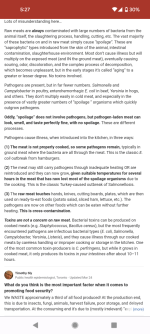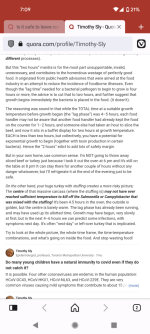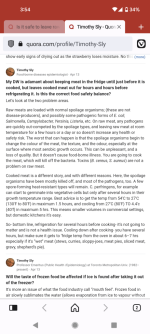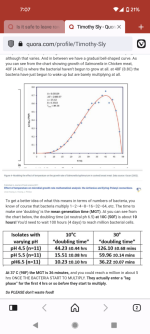Okay I've read a lot of posts before about people who screwed up. Not necessarily on this site. They left meat out too long before cooking it. Greater than the 2-hour limit..... In some case they left it in a car overnight..... Or they let their food cool off accidentally because their smoker went out.... And it got cool for several hours.
The answers given on the internet range the gamut from it's okay don't worry about it, with flawed reasoning usually, to to throw it away no way in hell should you eat that.
This is pretty much the same information here as in the Kruger files on this site only this is succinct. There's no hem hawing.
What's the real answer?
It's not easy to find cuz most people on the internet are parroting The normal FDA recommendations or limits.
To make it more complicated there's bacteria that spoilage bacteria that makes you sick that you can smell, and there's bacteria such as e coli that you can't smell or taste which can make you very sick or kill you.
So I've been hunting for the truth and it's hard to come by. From official sources that is. It's a lot like the recommendation to cook chicken to 165 f.... When that dries it out. 150 to 155 is much better as long as you get it there for the necessary time to pasteurize it.
Here's the basics of what I gathered, you should understand if you don't want to just throw an expensive piece of meat away if you screw up. Following the recommended guidelines is fine most of the time.
The only good concise information I could really find on this was explained by a professor emeritus of food illness epidemiology on his blog. He also used to be an inspector.
What he says: for raw meat..... If it smells good cook it. Don't worry about the time unrefrigerated. Spoilage bacteria on raw meat out competes pathogenic bacteria. And cooking properly kills all the spoilage bacteria. The FDA 2-hour limit out of the refrigerator is ridiculous and wastes food. You can keep meat out for hours or even a day at room temperature and still cook it and eat it. Recommendation for 2 hr is extremely conservative was made around commercial kitchens... Where you don't know what other steps previously items were not refrigerated in. The total time is really like 15 hours or so.... And there's also a lag time before bacteria even begins to grow of like 4 hours that takes you far past that 2 hour limit. In essence the 2-hour limit is simply does not apply at home at ambient temperatures. And that's if you were going to eat it You're not you're going to cook it which is going to kill all of this spoliage bacteria anyway. Toxins are not a problem on raw meat because the pathogenic bacteria are out competed by the vast numbers of easy growing spoilage bacteria. He points out that in much of the world meat is sold unrefrigerated all day long in markets.
On the other end, after you've cooked food..... All the spoilage bacteria has been eliminated and this is where the pathogenic bacteria has the ability to really grow. Or incomplete cooking where most of the spoilage bacteria has been eliminated. ......This is what you need to worry about. However you don't have to worry about it as quick as they say for the same reasons. There's a lag time again of 4 hours or more before bacteria even begins to grow when the food cools down into the unsafe zone. You can leave food out a few hours to cool down before putting it in the refrigerator it's fine. You typically have 6-7 to hours to not worry about. You can cool it to room temperature first. You don't have to throw food out because you didn't get it in the refrigerator in 2 hours.. he did a calculation for e coli which indicated that previously prepared, ready to eat food could be left out for as long as 15 hours before the level would get significant.
Now the catch 22 is that bacteria such as these pathogenic bacteria produce heat resistant toxins. They produce that reheating it does not kill it. It takes sterilization temperatures to get rid of the toxins of like 130c. So pathogenic bacteria time is more critical to limit after food is cooked.... Because reheating doesn't kill the toxins.
He basically points out that almost all cases of foodborne illness occur by...... Cross contamination...... Inadequate cooking of meat....... And undercooked hamburger. Undercooked hamburger is the worst place you really see ecoli that can kill people. This is due to the vast amount of surface area that ground meat has and bacteria can grow all throughout it instead of just on the outside.
So what made me bring this up? I screwed up Sunday night. I fell asleep and left my prepped brisket and sitting on the counter in the kitchen for about 5 hours before I woke up and put it on the smoker. It was almost to room temperature 60F. Because I knew this stuff, I went ahead and cooked it and it was great. I had to convince my wife so I had to dig up his blog info for her.......
I read before where people threw a $$$ brisket away because they exceeded that two hour time limit......... A while back there was a post on here from someone who smoker cooled off..... Brisket was 120 when they found it. People told them to go ahead and reheat it and it would kill the bacteria and the things would be fine and that's not necessarily true.... Because reheating won't kill toxins that are heat resistant from pathogenic bacteria. That case all depends on how long it was cool, and more importantly did it get hot enough to kill the pathogenic bacteria before it started to cool. But generally you've got quite a few hours before you have to worry about it if you got to a safe temperatute first ... Because there's a time lag before the bacteria even begin to grow and it's several hours alone once you get under 130F. . Thats 4 + hours you don't even have to worry about ....
Basically all these rules were limits were designed around commercial food preparation where somebody does not know the cumulative effect of stages of preparation, not for your kitchen. There's no need to waste perfectly good food. This professor says it as much as one third of all food is thrown out prematurely
The answers given on the internet range the gamut from it's okay don't worry about it, with flawed reasoning usually, to to throw it away no way in hell should you eat that.
This is pretty much the same information here as in the Kruger files on this site only this is succinct. There's no hem hawing.
What's the real answer?
It's not easy to find cuz most people on the internet are parroting The normal FDA recommendations or limits.
To make it more complicated there's bacteria that spoilage bacteria that makes you sick that you can smell, and there's bacteria such as e coli that you can't smell or taste which can make you very sick or kill you.
So I've been hunting for the truth and it's hard to come by. From official sources that is. It's a lot like the recommendation to cook chicken to 165 f.... When that dries it out. 150 to 155 is much better as long as you get it there for the necessary time to pasteurize it.
Here's the basics of what I gathered, you should understand if you don't want to just throw an expensive piece of meat away if you screw up. Following the recommended guidelines is fine most of the time.
The only good concise information I could really find on this was explained by a professor emeritus of food illness epidemiology on his blog. He also used to be an inspector.
What he says: for raw meat..... If it smells good cook it. Don't worry about the time unrefrigerated. Spoilage bacteria on raw meat out competes pathogenic bacteria. And cooking properly kills all the spoilage bacteria. The FDA 2-hour limit out of the refrigerator is ridiculous and wastes food. You can keep meat out for hours or even a day at room temperature and still cook it and eat it. Recommendation for 2 hr is extremely conservative was made around commercial kitchens... Where you don't know what other steps previously items were not refrigerated in. The total time is really like 15 hours or so.... And there's also a lag time before bacteria even begins to grow of like 4 hours that takes you far past that 2 hour limit. In essence the 2-hour limit is simply does not apply at home at ambient temperatures. And that's if you were going to eat it You're not you're going to cook it which is going to kill all of this spoliage bacteria anyway. Toxins are not a problem on raw meat because the pathogenic bacteria are out competed by the vast numbers of easy growing spoilage bacteria. He points out that in much of the world meat is sold unrefrigerated all day long in markets.
On the other end, after you've cooked food..... All the spoilage bacteria has been eliminated and this is where the pathogenic bacteria has the ability to really grow. Or incomplete cooking where most of the spoilage bacteria has been eliminated. ......This is what you need to worry about. However you don't have to worry about it as quick as they say for the same reasons. There's a lag time again of 4 hours or more before bacteria even begins to grow when the food cools down into the unsafe zone. You can leave food out a few hours to cool down before putting it in the refrigerator it's fine. You typically have 6-7 to hours to not worry about. You can cool it to room temperature first. You don't have to throw food out because you didn't get it in the refrigerator in 2 hours.. he did a calculation for e coli which indicated that previously prepared, ready to eat food could be left out for as long as 15 hours before the level would get significant.
Now the catch 22 is that bacteria such as these pathogenic bacteria produce heat resistant toxins. They produce that reheating it does not kill it. It takes sterilization temperatures to get rid of the toxins of like 130c. So pathogenic bacteria time is more critical to limit after food is cooked.... Because reheating doesn't kill the toxins.
He basically points out that almost all cases of foodborne illness occur by...... Cross contamination...... Inadequate cooking of meat....... And undercooked hamburger. Undercooked hamburger is the worst place you really see ecoli that can kill people. This is due to the vast amount of surface area that ground meat has and bacteria can grow all throughout it instead of just on the outside.
So what made me bring this up? I screwed up Sunday night. I fell asleep and left my prepped brisket and sitting on the counter in the kitchen for about 5 hours before I woke up and put it on the smoker. It was almost to room temperature 60F. Because I knew this stuff, I went ahead and cooked it and it was great. I had to convince my wife so I had to dig up his blog info for her.......
I read before where people threw a $$$ brisket away because they exceeded that two hour time limit......... A while back there was a post on here from someone who smoker cooled off..... Brisket was 120 when they found it. People told them to go ahead and reheat it and it would kill the bacteria and the things would be fine and that's not necessarily true.... Because reheating won't kill toxins that are heat resistant from pathogenic bacteria. That case all depends on how long it was cool, and more importantly did it get hot enough to kill the pathogenic bacteria before it started to cool. But generally you've got quite a few hours before you have to worry about it if you got to a safe temperatute first ... Because there's a time lag before the bacteria even begin to grow and it's several hours alone once you get under 130F. . Thats 4 + hours you don't even have to worry about ....
Basically all these rules were limits were designed around commercial food preparation where somebody does not know the cumulative effect of stages of preparation, not for your kitchen. There's no need to waste perfectly good food. This professor says it as much as one third of all food is thrown out prematurely
Attachments
Last edited:




